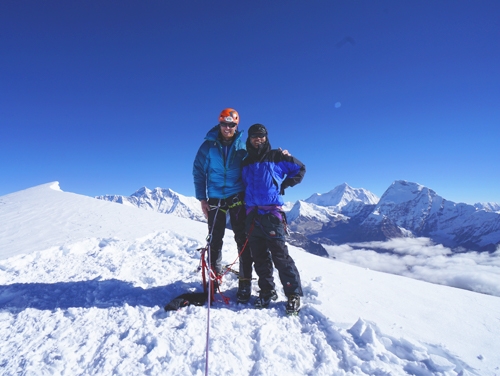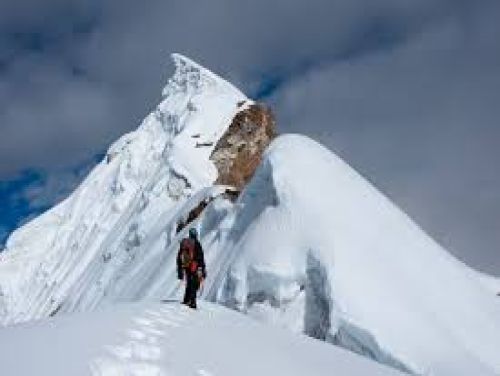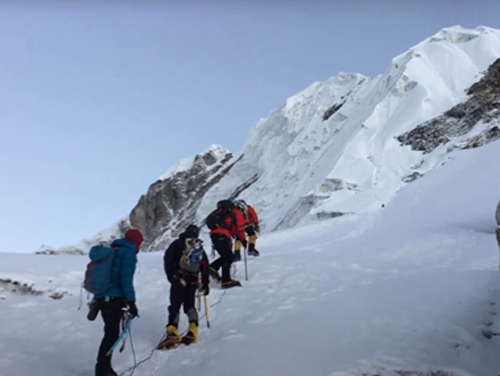Summary of Mera and Island Peak Climbing
The highest trekking peak in Nepal is Mera Peak, which rises to a height of 6,476 meters and is located south of Everest in the densely forested Hinku valley. A very excellent view of the semicircle Nuptse Sher in the north and Makalu in the east surrounds Island Peak, which is located in the center of the Khumbu region and is a portion of the south ridge of Lhotse Sher. Baruntse, Amphu, and Ama Dablam are to the south.
Mera Peak is less technical than Island Peak despite having to traverse higher passes and more challenging peaks. In addition, Island Peak's ascent is somewhat more difficult than Mera's.
Wander around the lush Yak pastures, which frequently have a sizable flock of Yak in the summer. Trek into the secluded area after passing through lovely rhododendron forests. Observe the wild, unspoiled valley, which continues to be a favorite habitat for many threatened plant and animal species.
Discover this lovely area while learning about the Sherpa people's way of life and local culture. This climbing excursion is obviously difficult, but it's also exciting. The highest trekking mountain in Nepal may be conquered when you join us at the Himalayan Odyssey.
How to Reach Mera and Island Peak climbing ?
The thrilling mountain flight touches down in Lukla (a.k.a Gateway of Everest Base Camp Trek). The opening days of the expedition follow off-the-beaten-path of Hinku valley to reach Mera Peak, leaving a busier road to Everest.
After spending several nights above 5,000 meters, it is important to take a high-altitude rest day to ensure that you are completely acclimated before making the last ascent to the Mera la High Camp. From the highest point of the Khumbu region of Everest, where the most technically challenging glaciated Amphu Laptsa Pass is located, the summit of Island Peak appears to be practically at the same level.
Island Peak requires a pleasant scramble, a fascinating granite ridge, and then onto a magnificent glacier with a gorgeous and breathtaking landscape to complete the ascent. After the ascent, we will return by following the Sherpa heartland. From here, it is a shorter trek back to Lukla to conclude the journey.
How Difficult are Mera and Island Peak climbing?
Mera Peak Difficulty
You'll need some technical climbing abilities to overcome the Mera Peak challenge. The final 30–40 meters is the only technically challenging part of the Mera Peak climb. The slope of the ice/snow in this little part is approximately 40 degrees. For this section, you will want basic mountaineering equipment such as an ice axe, fixed ropes, and crampons.
Amphu Labtsa Pass Difficulty
This part of climbing is more technical than Mera Peak. You will surmount a series of ice steps. You will use a fixed rope (for safety) for this to reach the rocky crest. You must have the knowledge of how to fix ropes and ice axe. Once on easier slopes, you will not need to use this.
Island Peak Difficulty
Even though Mera Peak is taller, Island Peak is more difficult on a technical level. On this trek, you must ascend 45-degree slopes coated with snow. On all of the exposed areas, you must use fixed lines. Rope climbing skills are a must for this climb. You need to have proper mountaineering training for this.
Food and Accommodation during Mera and Island Peak Climbing
Accommodations at the Mera and Island Peak Climbing may be in average teahouses maintained by residents in the area unless you prefer tents. The lodges you can assume are the cozy rooms, twin beds, mattresses, blankets, and a communal toilet as you ascend towards the high altitude levels with a tiny population.
There might not be many possibilities for food and lodging when they walk closer to rural areas with limited transit options. The common Nepalese meal, dal bhat, is one of the meals you will be served while on your treks.
Is a permit necessary for Mera and Island Peak climbing ?
Emergency evacuation while doing Mera and Island Peak Climbing
In Nepal, helicopter evacuations are the maximum usual method of managing an emergency, and there may be a well-set-up infrastructure for managing logistics. Incidents are uncommon, and Mera and Island Peak is positioned in a well-supported area of Nepal, along with the Himalayan Rescue Center in Pheriche.
It is virtually crucial to have travel insurance in the area and to be clear about your vacation spot and what you're doing to the insurance company. On the occasion of an emergency, the team, in addition to the guide, porters, and everybody else around might be accountable for moving a casualty.
This should take time and distance in a Himalayan surroundings like Mera and Island Peak. The maximum reason for delaying helicopter resources is awful weather. As a result, it's far crucial to understand that self-sufficiency and self-control are required withinside the mountains.
A helicopter evacuation may be organized through your insurance company. However, you may want to open a case and describe the situation to the insurance company. The best advice withinside the case of altitude sickness is to keep away from risk and descend. Further elevation can quickly result in far more serious cerebral or pulmonary edema, consequently, it is usually nice to descend if you're feeling truly unwell.
Booking is Open for 2025 and 2026
Best season for Mera and Island Peak Climbing
Weather is one of the important factors to look at and decide when you are traveling to high altitudes. You can see the live weather forecast, but it’s very hard to foretell being 100 % sure. So we highly recommend you visit during the spring season (March to May) or the autumn season (September to Early December).
It is best suited to trek during those seasons as the sky will be crystal clear, as the thick clouds will also fade. With these breathtaking views of mountains, the temperature will also be lovely with sunlight being warm temperature.
The Autumn season falls just after the Monsoon and there is greenery everywhere. Waterfalls, rivers, ponds, and lakes get refilled after the Monsoon season, and it looks beautiful. So, it's the proper time to enjoy the beauty of the water of Nepal. Moreover, the air is fresh and cool during the autumn. From mid-September, it's a time of clear skies and peaceful mountain views.
Why autumn season for Mera and Island Peak Climbing?
- Experience Visionary temperature for trekkers and climbers.
- Enjoy the clarity of panoramic mountains.
- Enjoy the festival season in Nepal.
- Fresh and dust-free terrain views.
- The spring season is known for the blooming rhododendron flowers and green vegetation.
- The paths to Mera and Island Peak are beautifully decorated with varied and colorful floras.
- The dry and bright weather provides clear visibility of the environment.
Why Spring season for Mera and Island Peak Climbing?
- Walk through the colorful blooming flowers and green tracks.
- Trek and climb in transparent, steady, and fair weather.
- Enjoy the clarity of mountains and terrains.
- Experience Nepal’s beauty like never before.



